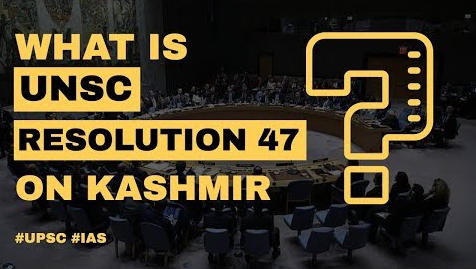Table of Contents
- After India scrapped Article 370 & 35A, the Pakistan Foreign Ministry said,
- “No unilateral step by the Government of India can change the disputed status, as enshrined in the United Nations Security Council (UNSC) resolutions.”



EVENTS BEFORE RESOLUTION 47
- On 1 January 1948, India took the matter to the UNSC under Article 35 of the UN Charter.
- Claimed that Pakistani nationals and tribesmen had attacked J&K.
- Requested the Security Council to prevent Pakistan from continuing its actions.
- India also stated that, despite holding the state’s legal accession, it was prepared to conduct a plebiscite to confirm the people’s wishes and abide by its results.

- In response, Pakistan denied involvement in the conflict and made counter-accusations claiming that India had acquired the state’s accession by “fraud and violence” and that it was conducting a “genocide” against Muslims.
RESOLUTION 47
- Adopted on 21 April 1948, was one of he 1st conflict that the UN set upon to resolve after it creation.

PART 1
- The Council increased the size of the Commission established by UNSC Resolution 39 to 5 members (with representatives of Argentina, Belgium, Colombia, Czechoslovakia and the United States)
- Instructed the Commission to go to the subcontinent and help the governments of India and Pakistan restore peace and order to the region and prepare for a plebiscite to decide the fate of Kashmir.
PART 2
- In the 1st step, Pakistan was asked to use its “best endeavours” to secure the withdrawal of all tribesmen and Pakistani nationals, putting an end to the fighting in the state.
- In the 2nd step, India was asked to “progressively reduce” its forces to the minimum level required for keeping law and order.
- It laid down principles that India should follow in administering law and order in consultation with the Commission, using local personnel as far as possible.
- In the 3rd step, India was asked to ensure that all the major political parties were invited to participate in the state government at the ministerial level, essentially forming a coalition cabinet.
- India should then appoint a Plebiscite Administrator nominated by the United Nations, who would have a range of powers including powers to deal with the two countries and ensure a free and impartial plebiscite.
- The resolution was approved by nine votes against none.
- The Soviet Union and Ukraine abstained.
AFTER RESOLUTION 47
- Both India and Pakistan raised objections to the Resolution 47.
- Pakistan objected to the retention of the Indian forces in Kashmir, even at the minimum level allowed by the resolution.
- India objected first of all that the resolution placed India and Pakistan on an equal footing, ignoring the complaint of Pakistani aggression and Kashmir’s legal accession to India.
- Secondly, it objected to the absence of allowance for it to retain troops in the state for its defence.

- The Simla Agreement, or Shimla Agreement, was signed between India and Pakistan on 2 July 1972.
- Both countries will “settle their differences by peaceful means through bilateral negotiations”.



Latest Burning Issues | Free PDF






















 WhatsApp
WhatsApp